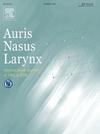Detailed evaluation of the risk of infraorbital nerve injury in postoperative maxillary cyst surgery
IF 1.5
4区 医学
Q2 OTORHINOLARYNGOLOGY
引用次数: 0
Abstract
Objective
Postoperative maxillary cyst (POMC) develops as a delayed complication after radical surgery. The infraorbital nerve (ION) is a terminal branch of the trigeminal nerve and is one of the low-frequency collateral injuries that may occur in maxillary sinus surgery. The risk of ION injury may increase during POMC surgery due to anatomical variations: however, this has not yet been examined in detail. Therefore, we herein investigated variations in the ION in POMC cases with a focus on its relationship with the aperture site of the cyst, to clarify the risk of injury.
Methods
A multifacility retrospective study was conducted between May 2014 and December 2023 on patients who underwent POMC surgery in Kagawa Medical University or Japanese Red Cross Asahikawa Hospital. Preoperative coronal CT images were reviewed from the viewpoint of anatomical variations in the ION and the risk of nerve injury.
Results
Eighty-four patients (95 sides), including 11 bilateral cases, were eligible. The presence of several risk factors for nerve injury was evaluated. The following outcomes were noted: contact between the opening site and ION (27.4 %), bony erosion of the infraorbital canal (35.8 %), descent of the ION from the orbital floor (16.8 %), and obscuration of the nerve run (17.9 %). The risk of injury was classified based on the results of imaging evaluations as follows: no risk (69 cases, 72.6 %), low risk (16 cases, 16.8 %), moderate risk (6 cases, 6.3 %), and high risk (4 cases, 4.2 %). A retrospective review revealed that ION injury occurred in only 1 patient (1.4 %) who was categorized as high risk.
Conclusion
Although the overall risk of ION injury is not very high, it is important to note that it may occur in some cases without precautions. Therefore, detailed CT with a focus on the ION to preoperatively assess the risk of nerve injury is important.
上颌囊肿术后眶下神经损伤风险的详细评价
目的上颌术后囊肿(POMC)是根治性手术后的一种延迟并发症。眶下神经(ION)是三叉神经的末梢分支,是上颌窦手术中可能发生的低频侧支损伤之一。在POMC手术中,由于解剖结构的变化,离子损伤的风险可能会增加:然而,这一点尚未得到详细的研究。因此,我们在此研究了POMC病例中离子的变化,重点研究了其与囊肿孔位置的关系,以阐明损伤的风险。方法对2014年5月至2023年12月在香川医科大学或日本红十字会旭川医院行POMC手术的患者进行多机构回顾性研究。从ION的解剖变化和神经损伤的风险角度回顾术前冠状位CT图像。结果84例患者(95侧)入选,其中双侧11例。对神经损伤的几种危险因素进行了评估。观察到以下结果:开口部位与离子接触(27.4%),眶下管骨侵蚀(35.8%),离子从眶底下降(16.8%),神经行梗阻(17.9%)。根据影像学评价结果将损伤风险分为无风险(69例,72.6%)、低风险(16例,16.8%)、中风险(6例,6.3%)、高风险(4例,4.2%)。一项回顾性研究显示离子损伤仅发生在1例(1.4%)高危患者中。结论虽然离子损伤的总体风险不是很高,但需要注意的是,在某些情况下,如果没有预防措施,离子损伤也可能发生。因此,术前以离子为重点的详细CT评估神经损伤的风险是很重要的。
本文章由计算机程序翻译,如有差异,请以英文原文为准。
求助全文
约1分钟内获得全文
求助全文
来源期刊

Auris Nasus Larynx
医学-耳鼻喉科学
CiteScore
3.40
自引率
5.90%
发文量
169
审稿时长
30 days
期刊介绍:
The international journal Auris Nasus Larynx provides the opportunity for rapid, carefully reviewed publications concerning the fundamental and clinical aspects of otorhinolaryngology and related fields. This includes otology, neurotology, bronchoesophagology, laryngology, rhinology, allergology, head and neck medicine and oncologic surgery, maxillofacial and plastic surgery, audiology, speech science.
Original papers, short communications and original case reports can be submitted. Reviews on recent developments are invited regularly and Letters to the Editor commenting on papers or any aspect of Auris Nasus Larynx are welcomed.
Founded in 1973 and previously published by the Society for Promotion of International Otorhinolaryngology, the journal is now the official English-language journal of the Oto-Rhino-Laryngological Society of Japan, Inc. The aim of its new international Editorial Board is to make Auris Nasus Larynx an international forum for high quality research and clinical sciences.
 求助内容:
求助内容: 应助结果提醒方式:
应助结果提醒方式:


